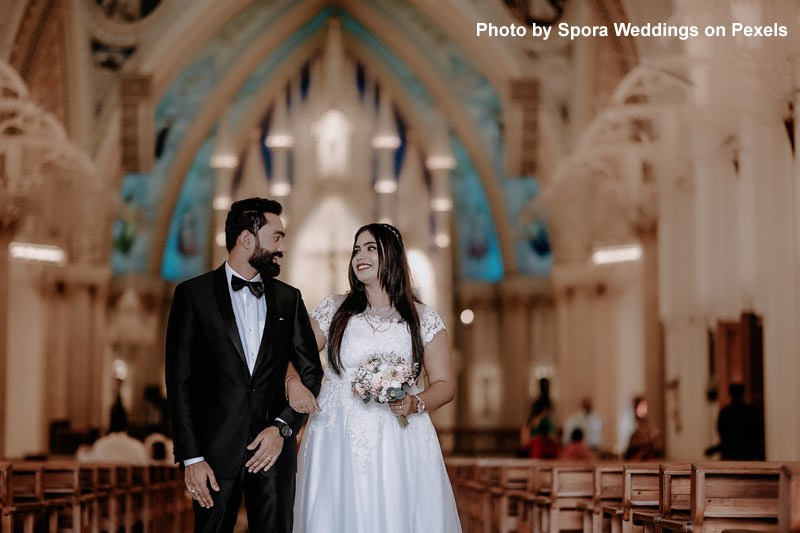Weddings are often a unique blend of cultural traditions from both parties in the couple. However, many weddings contain a religious component, which often drives the traditions practiced leading up to the wedding day and extending throughout the ceremony. The religious and faith-based elements demonstrate how important their faith is and how it plays a role in the foundation of their marriage.
Weddings in the Catholic Church are highly traditional events with many rituals and sacraments defined by the church leaders. Guests attending a Catholic wedding can expect the following religious traditions.
- Catholic engagements: Catholic engagements are expected to last between six months and a year. During this time, the couple is prepared for marriage by the priest and is encouraged to examine their belief systems to ensure they will be a good match. While different dioceses have different requirements, couples can expect the following things to occur during the engagement:
- An interview with the priest to help them understand your expectations for the wedding. The priest will also let the couple know the documentation requirements for the marriage and logistical information, such as available dates. If the marriage is interfaith, the priest must also know. There is no requirement for the other party to convert to Catholicism, but any children resulting from the marriage will be expected to be members of the Catholic faith.
- A prenuptial investigation to confirm that you are entering into the marriage freely, permanently, exclusively, and potentially for children. The couple will have two people testify using a notarized document that they meet these four basic tenets of marriage. The priest will also confirm that neither party has been previously married. If one party has been previously married but is now divorced, some Catholic churches will refuse to perform the ceremony.
- The priest may also require proof of baptism, Communion, and/or confirmation, which are Catholic rites that many people of the faith experience. If lieu of these documents, many priests will allow affidavits from two witnesses per rite.
- Pre-Cana, which is a marriage preparatory program provided by the church. This program may vary from one parish to another. Still, it generally requires multiple sessions with a priest, attendance in a mandated activity, such as a conference or retreat, and more active involvement in the church.
- Church wedding: In the Catholic faith, marriage is considered a covenant with God. As such, the only place you can be married is inside a church, which emphasizes the ceremony’s sanctity. No outdoor weddings are allowed. Fortunately, many Catholic churches are majestic buildings providing a beautiful ceremony venue.
- Dress code: There is technically no dress code for guests at a Catholic wedding, but these formal events are generally very modest. Women wearing dresses that leave the upper body exposed may include a shawl or wrap for the ceremony.
- Introductory rites and opening prayer: Once everyone is seated and the wedding processional has concluded, Catholic weddings open with the priest leading everyone in the sign of the cross and an opening prayer. Guests and the wedding party will be expected to stand during this time.
- Nuptial Mass or Celebration of Marriage: Couples can decide whether to have a Catholic ceremony with or without Mass. If they include Mass, the ceremony can last up to an hour longer and include Holy Communion. If both parties of the wedding are Catholic, they can choose to have a full Catholic wedding ceremony Nuptial Mass, which includes readings from the Old Testament and the New Testament, hymns, and psalms. After this time, the priest offers a homily, which includes teachings and readings about marriage and love. Alternatively, a Celebration of Marriage may occur instead of a Nuptial Mass. This option starts with the Liturgy of the Word, which has readings of Bible passages selected by the couple and approved by the priest, followed by a short sermon about marriage delivered by the priest.
- Rite of Marriage: This portion of the ceremony includes the priest asking the couple to take their vows, which include promising to take the other party “to have and to hold, from this day forward, for better or for worse, for ricke or for poorer, in sickness and in health, to love and cherish until death do you part.”
- Ring Exchange: After the vows, the best man will give a ring to the priest for a blessing. Afterward, the groom will place the ring on the bride’s finger. Then, the maid of honor will give the groom’s ring to the priest to be blessed, and the bride will place it on the groom’s finger.
- Wedding conclusion without Mass: If the couple opts to forego the Nuptial Mass, the ceremony will conclude with nuptial blessings and a final prayer. The priest will instruct guests to “go in peace with Christ.” Guests are expected to respond by saying, “Thanks be to God.”
- Wedding conclusion with Mass: If the Nuptial Mass is included in the ceremony, several events will occur, although they may vary depending upon the parish.
- Offertory/Liturgy of the Eucharist: This event is when the altar is prepared for Communion. The couple or guests may help prepare the bread and wind, and the priest delivers Eucharist Paryers over these items for Communion. In some Catholic weddings, the bride will place flowers on the Blessed Virgin Mary.
- The Lord’s Prayer is recited.
- The priest provides a nuptial blessing and offers a sign of peace, which guests are expected to do as well. This is generally a handshake while saying, “Peace be with you,” to those near you.
- Communion: It is important to note that guests who are not Catholic may not receive Communion. However, they may receive a blessing from the priest instead. Usually, guests can signify they are not of the Catholic faith by crossing their arms across their chest. Catholic guests will receive the host (bread) and wine while other guests sing.
- Blessing and Recessional: After Communion, the ceremony ends with a final blessing, and everyone is dismissed. The wedding couple will lead all guests out of the church in a recessional.
Catholic weddings are steeped in tradition and formality, which can be intimidating for non-Catholic guests. However, understanding these religious traditions can prepare guests for what to expect when attending a Catholic wedding.
Wedding Details is your comprehensive guide to all aspects of your wedding. From traditional ceremonies to questions regarding the guests, our website offers you one place to do all your research.

